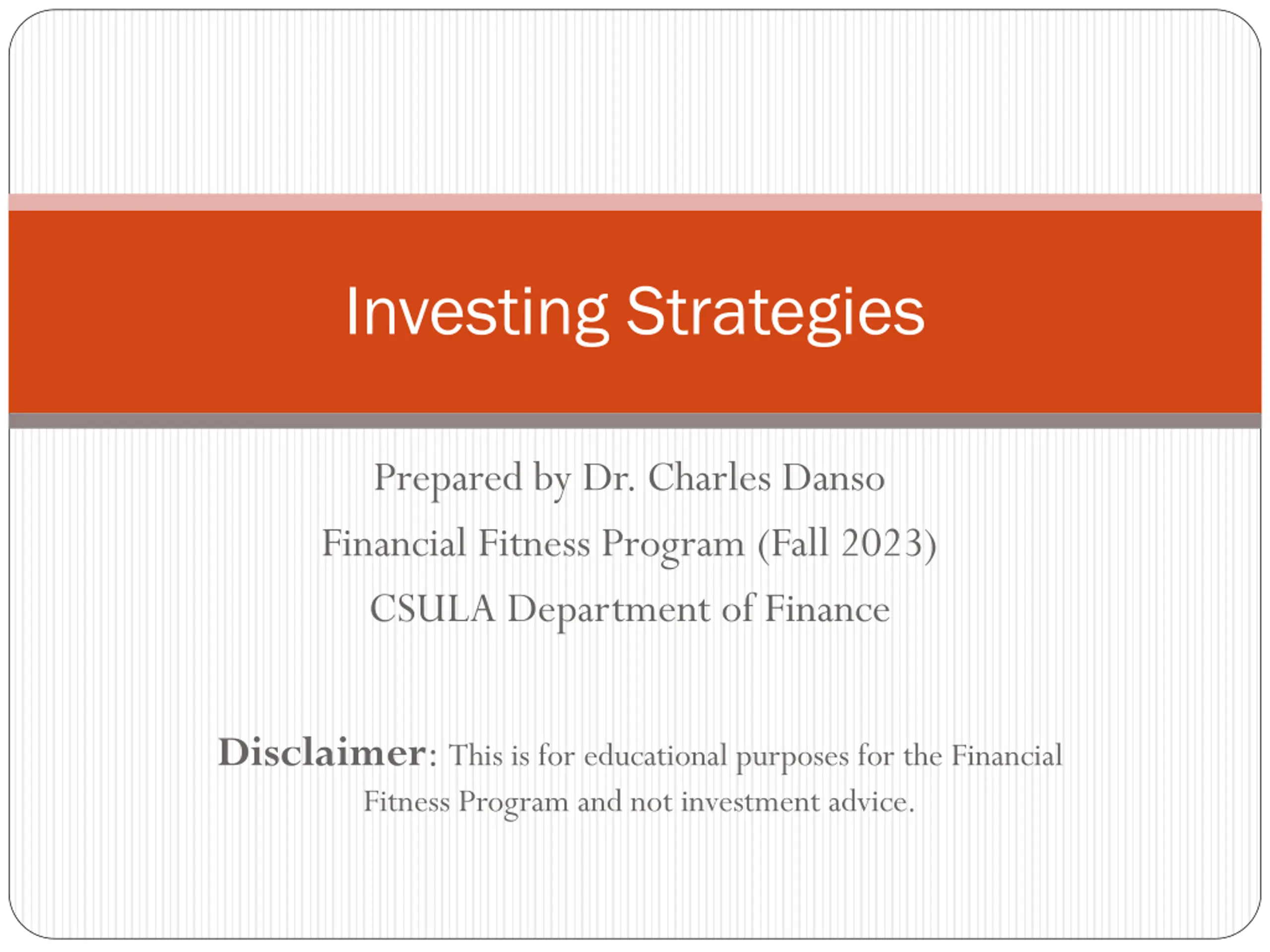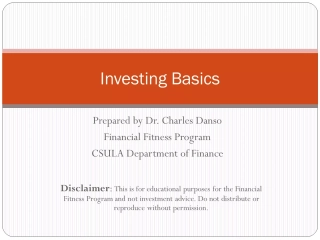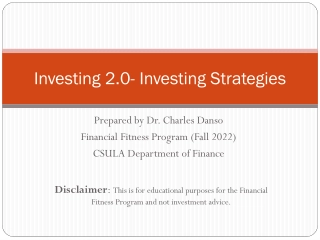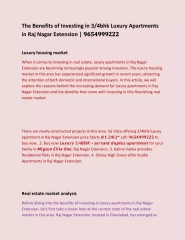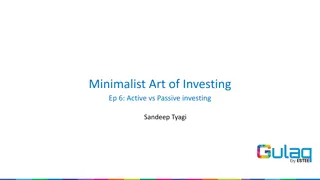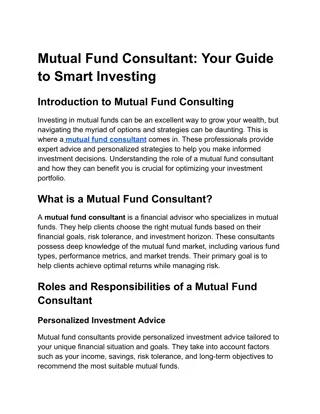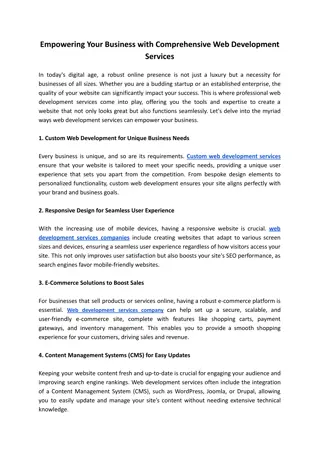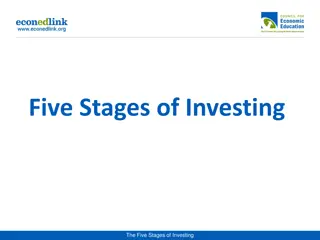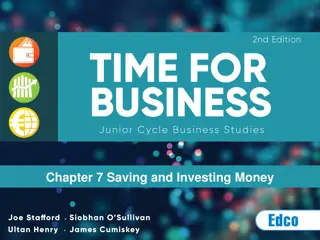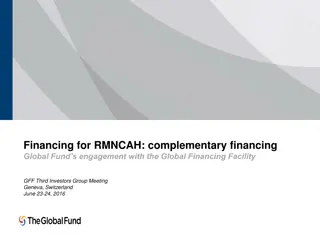Investing Strategies
Get comprehensive guidance on investing strategies, risk tolerance, and types of investors. Understand the importance of setting investment goals and managing emotions while investing. Learn how to assess your risk tolerance and make informed investment decisions for a secure financial future. Popular
Download Presentation

Please find below an Image/Link to download the presentation.
The content on the website is provided AS IS for your information and personal use only. It may not be sold, licensed, or shared on other websites without obtaining consent from the author.If you encounter any issues during the download, it is possible that the publisher has removed the file from their server.
You are allowed to download the files provided on this website for personal or commercial use, subject to the condition that they are used lawfully. All files are the property of their respective owners.
The content on the website is provided AS IS for your information and personal use only. It may not be sold, licensed, or shared on other websites without obtaining consent from the author.
E N D
Presentation Transcript
Investing Strategies Prepared by Dr. Charles Danso Financial Fitness Program (Fall 2023) CSULA Department of Finance Disclaimer: This is for educational purposes for the Financial Fitness Program and not investment advice.
What Is Your Reason for Investing Retirement Purchase Goal Job Income Replacement Income supplement Target purchases Savings (education goals, health accounts) Investing out of DESPERATION is not advisable. 2
Types of Investors Active Investors Speculators: Hoping to profit investing in something but also expecting a probability and possibility of loss Hedgers: To create certainty in investment outcome by taking an opposite position to offset losses Arbitrageurs: Taking advantage of market mispricing or imperfections to make profit Involves simultaneously buying and selling the same asset in mispriced markets (for example) Passive Investors 3
Before Investing Ensure it is within your budget & ability Do you have an emergency fund established? Are you capable of losing the amounts you invested? Do you know your risk tolerance level? Have you determined your (ST & LT) investment goals? What is your lifecycle stage? Have you understood and accepted that there is the probability of loss with investments? Do not invest out of emotions solely such as fear, desperation, etc. 4
What is your risk Tolerance level Risk Tolerance: Level of risk an investor is willing to take on Risk Capacity: How much loss one can comfortably manage given present circumstances PASS Allocation Score by William Droms & Steven Strauss More commonly used by practitioners and advisors Using Questionnaires Some investment platforms already have some (read disclaimers) https://www.investright.org/informed-investing/know- yourself/test-your-risk-tolerance/ https://pfp.missouri.edu/research/investment-risk-tolerance- assessment/ 5
Risk Pyramid In Investing NOTE: There is potential to lose money in investing since gains or profits are not guaranteed. With higher risk, there is likelihood of higher gains and similarly, higher losses. 6
Psychology of Investing Role of emotions Fear Greed Desperation Some behavioral Biases in investing include: Overconfidence bias Familiarity bias Loss aversion Self-attribution bias, etc. 7
Types of Assets Stocks Bonds Derivatives Options Futures Forwards Swaps Alternative Investments Traditionally applied to investments outside of stocks & bonds Art, Jewelry, vintage, collector s items, antiques, etc. Real Estate 8
Investment Theories (for most assets) Fundamental Analysis: Assume that a stock s intrinsic or real value is determined by the company s future earnings Fundamental analyses include: Expected earnings, Financial strength of the company, Industry, New product development, Economic growth of the overall economy, etc. Technical Analysis: Based on the assumption that a stock s market value is determined by the forces of supply and demand in the stock market as a whole Deviates from fundamentalism by assuming that past market trends can predict the future direction for the market as a whole instead of fundamental value. Chartists plot past price movements and other market averages to observe trends they use to predict a stock s future value. Efficient Market Hypotheses (EMH) Based on the assumption that stock price movements are purely random. A stock s current market price reflects its true value (News??). It is impossible for an investor to outperform the average for the stock market as a whole over a long period of time unless they pick riskier investments (beta & Alpha) Behavioral theories adopted based on contrary evidence or observations (i.e. violations) 9
Investing Rule of Thumb General Rule of Thumb: Buy when price are low & sell when high E.g. buy product low & sell when high E.g. Buy stock when low and sell when high Buy when you expect stock to increase E.g. short sell stock if you expect stock to decrease to make profits Million dollar question? When is something priced low vs when is it priced high? Rarely do anyone know with certainty. This is where speculation comes into the picture. It is a guess at best, unless there is some informational and skill advantage (which can be illegal if insider trading) 10
Investment Strategies Many can be applied in different time horizons (ST or LT) Passive Strategies Passive Strategies Active Strategies Active Strategies Buy and Hold (LT strategy) Index Investing Index Funds, ETFs Dollar Cost Averaging Passive Real Estate Investing. E.g. REITs Dividend Investing Mutual Funds Day & Swing Trading Value Investing Growth Investing Sector Investing/Rotation Contrarian Investing Hedging Strategies Derivatives Trading 11
Active Strategies - Personas Name Person A Person B Age 35 28 Risk tolerance High High Occupation Full time trader Software Engineer Technical analysis Technical & Fundamental analyses Investment preference Chart Patterns Options contracts Real-time news Options trading strategies like straddles, spreads Horizon Short terministic Time commitment Daily Regular (if not daily) 12
Passive strategies -Personas Name Person X Person Y Age 60 45 Risk tolerance Moderate to low Moderate Occupation Inherited wealth Finance professional Managed portfolio (professionals) Value investor who uses fundamental analyses Investment preference Wealth preservation Diversified portfolio Consistent income Diversified stocks to hold LT Horizon Medium- long term Long-Term Time Commitment Minimal involvement Periodic involvement 13
Buy-and-hold Strategy Investors buy assets with the intention of holding them for an extended period Period is often years or decades. Example of assets are stocks & real estate The focus is on long-term appreciation, dividend income, and compounding returns. Minimal trading and portfolio turnover. Generally long-term strategy. 14
Index Investing Investors allocate their funds to passive investment vehicles like index funds or exchange-traded funds (ETFs) These funds aim to replicate the performance of a specific market index (e.g., S&P 500). Some are specialized along sectors, market, size, asset type E.g. oil ETFs, emerging markets, sector ETFs, ESG focused, etc. Provides broad market exposure and diversification Diversification involves spreading your investment across a variety of assets or asset classes to reduce risk. Don t put all eggs in one basket E.g. investing in stocks and real estate, or in different stocks from different industries at different stages of their company lives. Generally long-term strategy. 15
Dollar Cost Averaging Investors regularly invest a fixed amount of money regardless of market conditions. This can be a fixed amount at regular intervals. E.g. contribution to retirement lans This can be investing in a fixed quantity at regular intervals This strategy helps reduce the impact of market volatility over time. Particularly popular for retirement savings. Generally long-term strategy 16
Real Estate Investing (Passive) Investors buy shares in real estate investment trusts (REITs) or crowdfunding platforms. These investments provide exposure to real estate markets without direct property ownership. Passive income generated from rental income and potential capital appreciation. Generally long-term strategy 17
Dividend Investing Investors focus on stocks or funds that pay consistent dividends. Paying dividends are seen as a positive sign since it is a commitment to pay these cash flows consistently The goal is to generate passive income from dividend payments over time. Dividend-focused ETFs and mutual funds are popular choices for passive dividend investors. Generally long-term strategy 18
Day & Swing Trading Day Trading Traders actively buy and sell assets within short timeframes, ranging from minutes to days (day trading) Requires in-depth technical analysis and market monitoring. Swing Trading Traders actively buy and sell assets within short timeframes ranging from few days to weeks 19
Value Investing Investors seek undervalued assets with the expectation that their true value will be recognized in the future. Fundamental analysis is used to identify stocks or other assets trading below their intrinsic value. 20
Growth Investing Investors focus on assets with high growth potential, often in emerging industries. The goal is to profit from capital appreciation as the asset's value increases over time. Commonly associated with technology and innovative companies. 21
Sector Investing/Rotation Investors allocate assets to sectors or industries based on their analysis of economic and market trends. The goal is to move investments into sectors expected to outperform in a given economic climate. 22
Contrarian Investing Contrarian investors go against prevailing market sentiment. They may buy when others are selling (and prices are low) or sell when others are buying (and prices are high). Rely on the belief that markets can be irrational in the short term. Rely on the belief that markets will correct eventually from value driven from irrationality What goes up must come down take the down position when things are up, and up position when things are down 23
Hedging & Derivatives Strategies Investors use derivatives to hedge against potential losses or to speculate on price movements. Examples of derivatives include options contracts, futures contracts, swap contracts, etc. These strategies can be complex and require a deep understanding of financial derivatives. Hedging involves taking an offsetting position or using a financial instrument to reduce the risk associated with an existing investment or financial transaction. While primarily to limit losses, it can be dynamically or in combination strategy to speculate E.g. combination strategies which limit losses while leaving the possibility of unlimited profits 24
Investment Strategies & Horizons Short Term (Active) Short Term (Active) Day Trading Buying on Margin Short Selling Borrowing stock, selling & holding cash Return stock when bought at a lower price if stock price dips Pair trading: Holding offsetting positions in the same assets Trading using derivatives. Solo or combinations Long Long- -Term Term Dollar cost averaging If LT strategy Generally passive strategies that involve buy and hold E.g. Indexing, mutual funds, dividend investing, etc. If sold in a short period will change horizons 25
Trading Strategies by investment theory Technical Analyses Fundamental Analyses Value investing Growth investing Other strategies like P/E Effect (exception to EMH) EMH Behavioral Day trading Swing Trading Technical trading strategies like odd Lots Trading, Charting,etc Dollar Cost averaging Index investing EMH associated anomalies like January effect, small firm effect, value line effect, etc Contrarian Investing Momentum investing Dividend investing (could also be argued as fundamental) Hedging & derivatives 26
Bonds (or Debt instruments) Bond Laddering: having bonds with different maturities With each bond maturity, investor buys new bonds than exist in portfolio Tax Swap: Taking loss from a bond and a profit from another bond May or may not offset each other Barbells: owning both long & short term bonds Selling one set with interest rate movements Bullets: Used when expecting a balloon payment in the future Little payments in the beginning, then receive a lump sum in the future. (e.g. Zero-Coupon bonds, etc) 27
Derivative Assets (Contracts) Derivative Contracts: A contract whose value comes from the underlying asset. Since these are contracts, they are legally binding Options Contract: PUT or CALL Confers the right BUT not obligation to buy (for CALL options) or sell (for PUT Options) the underlying asset at a given price at a point in the future. These are usually for financial instruments Futures Contracts Obligation to buy/sell underlying asset at a given price at a specific time in the future Done mostly for commodities, but can exist for securities Transactions are standardized in size Forward Contracts Customized between two parties to buy/sell underlying asset at a specific price at a given time in the future Mostly done for currencies (Forex) Derivative Contracts tend to be risky and complex Usually suggested to have some experience trading in other financial instruments (that act as underlying assets) before venturing into these areas You can use Paper/Virtual Trading to get some experience first with no risk 28
Derivatives Strategies- Options Single Option Strategies Purchasing or selling calls Purchasing or Selling Put Options Combination Strategies Covered Call: Buy underlying asset and sell call option Married or protective Put: Buy underlying asset and buy put options Straddle (buying, i.e. long straddle or selling, i.e. short straddle) Buying a put and a call option with same expiration & strike price Goal is to profit regardless of the direction of the stock movement Profitable when price of underlying asset increases or decreases beyond cost of premium. Strangle (buying, i.e. long strangle or selling, i.e. short strangle) Buying a put and a call option with same expiration & different strike price Collar (i.e. protective put and covered call) If you bought underlying asset, buy a put and sell a call Used to prevent against large losses, but reduces large gains Option Spreads: Examples include Bull Call Spread , Bear Put Spread , Butterfly Spreads (combines Bull spreads with bear spreads) Other Strategies include, iron Condor , Protective Collar , 29
Derivatives Strategies- Futures Taking Long position (i.e. Buying) Taking short position (i.e. selling) Calendar Spread: Buying & Selling contracts for the same underlying asset with different expiration dates Bull Calendar Spread Long (i.e. buy) short-term contract & short (i.e. sell) long-term contract Bear Calendar Spread Short (sell) the short term contract, & long (buy) the long-term contract 30
Investment Portfolio & Diversification Portfolio: Combination of financial investments Provides Diversification: Having different investments so your risk is not concentrated in one type of investment or asset. Reduces overall risk in a portfolio over time Stock Portfolio Combination of different stocks ONLY Reduces risk exposure to one or few stocks Bond Portfolio Combination of different bonds ONLY Reduces risk exposure to one or few stocks Investment Portfolio Combination of different investments such as stocks ,bonds, options Reduces risk exposure to one or few types of assets Note: Diversification does not allow highest return possible for a single asset. However, risks are spread among assets not correlated. 31
Types of Orders (Buy/Sell) Transactions Market order: Request to buy or sell stock immediately (at market value now) Used when speed is preferred to than price Limit order: Request to buy or sell a stock at a specified price or better. Used when price is more important than speed of trade Stop-loss order (or stop order): To limit loss Request to buy or sell a stock after it reaches a specified price Then after that that, it trades at next chance (i.e. market order) E.g. sell a stock if it drops from $15 to $10, then sell at the market rate that exists once the price drops to $10 Stop-Limit Order: Combines a Stop with a limit order Once a stop price is reached, converts to a limit order/price E.g. Stock Price is $35, a stop order is placed at $28 to sell if it reaches that price. Then a limit is placed at $24 (i.e. sell only at $24 or above) Trailing Stop Order: Similar to stop order but based on percentage change in market price E.g. stock is bought at $30, but a trailing stop order is placed for 20%. Therefore stock would be sold when price reduces 20% or more. Can be applied to sales 32
Tax Implication of Trading Short Short- -Term Capital Gains Term Capital Gains Long Long- -Term Capital Gains Term Capital Gains Stocks held less than a year (ordinary income tax rate) Real Estate Stocks held more than a year (0%,15%, or 20%) Dividend income 33
Tax Implications in Retirement Assets Withdrawal Penalties Withdrawal Penalties Taxes To Expect Taxes To Expect Ordinary Income when withdrawals occur at retirement (except Roth) Ordinary income after withdrawal before retirement Required Minimum Distribution (RMD) Withdraw a % or govt taxes At age 72 govt starts taking money out if you have not withdrawn any money Typically 10% if withdrawn before retirement age 401(k) before 59.5years 403(b) before 59.5 years 457(b) No penalty IRA before 59.5 Roth IRA before 59.5 34
Questions??? 35
Tools of Technical Analyses Using Charts: Plotting historical prices to determine pattern, and using moving averages. Trends such as support vs resistance. Market Volume: market volume along with direction of market movement captures investor sentiment Linked to investor sentiment in behavioral finance Short Interest: provides insight into future demand for a stock. E.g. large short positions need to be bought and indicate built up demand. Linked to Contrarian strategy in behavioral finance Odd Lot Trading: Taking the opposite trades of retail investors who trade less than 100 shares Linked to contrarian strategy in Behavioral finance Dow Theory: A signal but not predictor of an end to bull or bear markets. Foundational series of writing that gave birth to tenets in technical analyses Breadth of the Market: Measure of number of stocks increasing in value versus the opposite. Somewhat linked to momentum trading in behavioral finance Advance Decline Line: difference between number of stocks that closed up versus those that lost value 36
